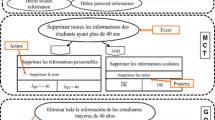Abstract
We focus exclusively on the issue of Requirements engineering for Data Warehouses (DW). Our position is that the information content of a DW is found in the larger context of the goals of an organization. We refer to this context as the organizational perspective. Goals identify the set of decisions that are relevant which in turn help in determining the information needed to support these. The organizational perspective is converted into the technical perspective, which deals with the set of decisions to be supported and the information required. The latter defines Data warehouse contents. To elicit the technical perspective, we use the notion of an informational scenario. It is a typical interaction between a DW system and the decision maker and consists of a sequence of pairs of the form, <information request, response>. We formulate an information request as a statement in an adapted form of SQL called Specification SQL. The proposals here are implemented in the form of an Informational Scenario Engine that processes informational scenarios and determines Data Warehouse Information Contents.














Similar content being viewed by others
References
Wong ST, Hoo KS Jr, Knowlton RC, Laxer KD, Cao X, Hawkins RA, Dillon WP, Arenson RL (2002) Design and applications of a multimodality image data warehouse framework. J Am Med Inf Assoc 9:239–254
Miller LL, Honavar V, Barta T Warehousing Structured and Unstructured Data for Data Mining, http://www.asis.org/annal-97/whouse.htm
Inmon WH (1996) Building the data warehouse, Wiley, New York
Ballard C, Herreman D, Schau D, Bell R, Kim E, Valencic A, Data modeling techniques for data warehousing, http://www.redbooks.ibm.com
Jarke M, Jeusfeld A, Quix C, Vassiliadis P (1998) Architecture and quality in data warehouses. In: Pernici B, Thanos C (eds) Proceddings of 10th CAiSE Conference, Springer, Heidelberg, pp 93–113
Rilson F, Freire J (2003) “DWARF: AN approach for requirements definition and management of data warehouse systems”. In: Proceeding of the 11th IEEE international requirements engineering conference, September 08–12, pp 1090–1099
Golfarelli M, Rizzi S (1999) Designing the data warehouse: key steps and crucial issues. J Comput Sci Inf Manage 2(3)
H¨usemann B, Lechtenb¨orger J, Vossen G (2000) Conceptual data warehouse design. In: Proceedings of the international workshop on design and management of data warehouses (DMDW’2000) Stockholm, Sweden, June 5–6
Boehnlein M, Ulbrich vom Ende A (1999) Deriving initial data warehouse structures from the conceptual data models of the underlying operational information systems. In: Proceedings of workshop on data warehousing and OLAP (DOPLAP), Kansas City, MO, USA
Kimball R, Reeves L, Ross M, Thornthwaite W (1998) The data warehouse lifecycle toolkit. Wiley, New York,
Frendi M, Salinesi C (2003) Requirements engineering for data warehousing, Proc. REFSQ Workshop
Winter R, Strauch B (2003) Information requirements engineering for data warehouse systems. In: ACM symposium on applied computing (SAC’04) Nicosia, Cyprus
Giorgini P, Rizzi S, Garzetti M (2005) Goal-oriented requirement analysis for data warehouse design, DOLAP’05. In: Proceedings of the 8th ACM international workshop on Data warehousing and OLAP, November 4–5, Bremen, Germany
Bonifati A, Cattaneo F, Ceri S, Fuggetta A, Paraboschi S (2001) Designing data marts for data warehouses. ACM Trans Softw Eng Methodol 10(4):452–483
Prakash N, Gosain A (2003) Requirements driven data warehouse development, CAiSE Short Paper Proceedings, pp 13–17
Prakash N, Singh Y, Gosain A (2004) Informational scenarios for data warehouse requirements specification, conceptual modeling-ER’2004. In: Atzeni P, Chu W, Zhou S, Ling TK (eds) LNCS 3288, Springer, Heidelberg, pp 205–216
Turban E, Aronson Jay E (1998) Decision support systems and intelligent systems, 5th edn. Prentice-Hall, Englewood Cliffs
Makarov IM, Vinogradskaya TM, Rubchinsky AA, Soko- lov VB (1987) The theory of choice and decision making. Mir Publishers, Moscow
Simon HA (1977) The new science of management decision. Prentice Hall, Englewood Cliffs
Jackson M (1995) Software requirements & specifications—a Lexicon of practice, principles and prejudices. ACM Press, Addison-Wesley, Reading
van Lamsweerde A (2000) Requirements engineering in the year 2000: a research perspective. In: Proceedings of 22nd international conference software engineering, Limerick, June 2000. ACM, New York
Dardenne A, van Lamsweerde A, Fickas S (1993) Goal directed requirements acquisition. Sci Comput Program 20:3–50
Anton AI (1997) Goal identification and refinement in the specification of software-based information systems, PhD Dissertation, Georgia Institute of Technology, Atlanta GA
Costello TW, Zalkind SS (1963) Psychology in administration: a research orientation. Prentice Hall, Englewood Cliffs
Fishburn PC (1964) Decision and value theory. Wiley, New York
Churchman CW (1968) Challenge to reason. McGraw-Hill, New York
Matsatsinis NF, Siskos Y (2002) Intelligent support systems for marketing decisions. Springer,Heidelberg
Thomsen E (2002) OLAP solutions: building multidimensional information systems. 2nd edn. Wiley, New York
Ponniah P (2001) Data warehousing fundamentals. Wiley, New York
March, James G (1991) How decisions happen in organization. Hum Comput Interact 6(2):95–117
Mylopoulos J, Chung L, Nixon B (1992) Representing and using nonfunctional requirements: a process-oriented approach. IEEE Trans Softw Eng 18(6):483–497
van Lamsweerde A (2001) Goal-oriented requirements engineering: a guided tour. Invited paper for RE’01—5th IEEE international symposium on requirements engineering, Toronto, August, pp 249–263
Sutcliffe A, Maiden N (1993) Bridging the requirements gap: policies, goals and domains. In: Proceedings of IWSSD-7—seventh international workshop on software specification and design, IEEE
Rolland C, Grosz G, Kla R (1998) A proposal for a scenario classification framework. Requir Eng J
Yu ESK (1997) Towards modelling and reasoning support for early phase requirements engineering. In: Proceedings of third IEEE symposium on requirements engineering, pp 226–235
Giunchiglia F, Mylopoulos J, Perini A (2004) The tropos software development methodology: process, models and diagrams. Auton Agents and Multi Agent Syst 8(3):203–236
Informix Guide to Designing Databases and Data Warehouses (2000) Informix Press
Author information
Authors and Affiliations
Corresponding author
Rights and permissions
About this article
Cite this article
Prakash, N., Gosain, A. An approach to engineering the requirements of data warehouses. Requirements Eng 13, 49–72 (2008). https://doi.org/10.1007/s00766-007-0057-x
Received:
Accepted:
Published:
Issue Date:
DOI: https://doi.org/10.1007/s00766-007-0057-x




